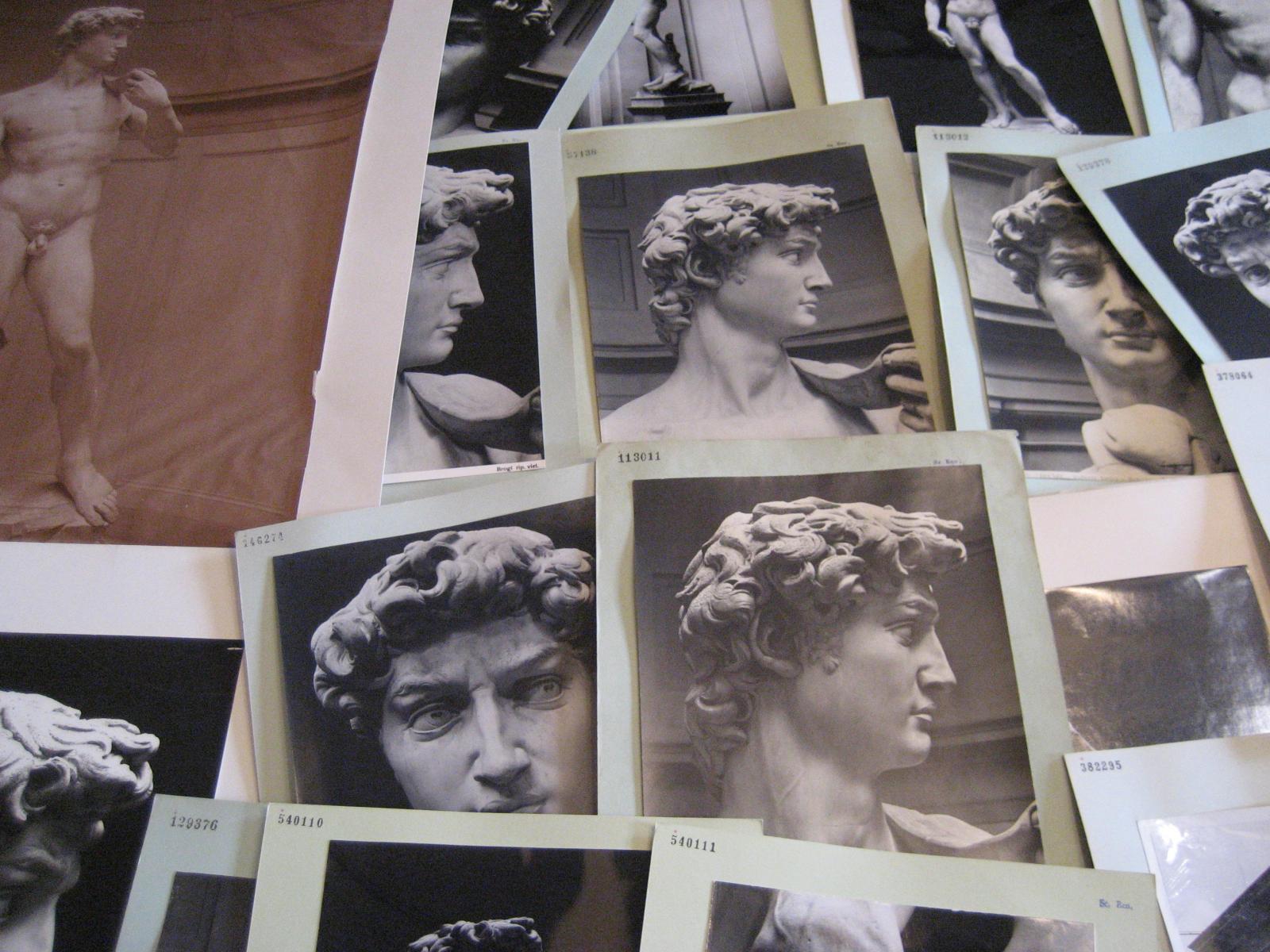The photographic cut and cutting practices in photographic archives
Costanza Caraffa
English abstract
The theme of the cut, of the portion of reality that the photographic technique cuts out and freezes outside the time-space continuum, is intrinsic to photography. It has been analyzed by important curators and critics. A milestone was provided in 1966 by John Szarkowski with his exhibition and catalogue The Photographer’s Eye at The Museum of Modern Art in New York. Szarkowski outlines his thoughts on the nature of photography through a comparison with previous picture-making processes, and in particular with painting: “paintings were ‘made’ […] but photographs […] were ‘taken’” (Szarkowski 1966, 6). The past tense reveals Szarkowski’s attempt at a historicization of photography, and in fact the catalogue and the exhibition presented pictures by various photographers from the entire lifespan of photography: pictures that share no vision or aesthetic theory, they are just “unmistakably photographs” (Szarkowski 1966, 7). This point is important to him since Szarkowski’s concern is to demonstrate the autonomy of photography from other media and arts. The radical innovation brought by photography is that it is “a process based not on synthesis but on selection” (Szarkowski 1966, 6). Szarkowski does not use the term ‘cut’ but rather ‘frame’ and argues: “the photographer’s picture was not conceived but selected […]. The central act of photography, the act of choosing and eliminating, forces a concentration on the picture edge” (Szarkowski 1966, 9). “Cropping” from the actual world and “immobilizing these thin slices of time” makes the essence of photography a visual production: “the result is not a story but a picture” (Szarkowski 1966, 10).
Complementary to this position is the 1981 exhibition and catalogue again at the MoMA in New York: Before photography: painting and the invention of photography, curated by Peter Galassi. He recognizes a sort of pre-photographic vision already in early 19th-century paintings and investigates the way to frame through paintings, later championed by Edgar Degas. Here, in general, the cut is a manifestation of the artist’s intention. However, returning to photography, something always escapes this intention, like the fly that got caught in 1870 on a collodion plate by Antonio Beato impressed in Cairo (Geimer 2007, 12-15). In his 1983 essay L’acte photographique, Philippe Dubois offers a theory of the photographic cut (in French coupe, but Dubois also uses from time to time the English term cut). The corresponding chapter (Dubois 1983, 151-202) follows a first part of the book which is devoted to the index and the relationship between photographic images and reality.
Compared to Szarkowski, Dubois further explicates the triangulation between cut, time and space: the photographic act is the radical gesture of a cut that cuts both the temporal thread and the spatial continuum. The photograph is cut out from life and photography is presented as an art made by cutting, with a knife, from the space-time of the real world. Dubois powerfully equates the photographic act to a knife or a guillotine blade cutting out “une tranche unique et singulière d’espace-temps” (“a singular slice of space-time”, Ibid. 151; here it is impossible not to think of Walter Benjamin’s “tiny spark of contingency” and Roland Barthes’s “that-has-been” in front of the camera). Dubois also draws attention to the relation between what is visible in the photograph and what the photographic act makes invisible, but still exists: the off of a photograph, framed by the gaze of the camera and only apparently cut out. One could question these positions about photography as selection and cut and argue with Christopher Pinney (2003) that photographic technology never excludes, always includes. The excess of photography challenges, again, the intention of the photographer: “however hard the photographer tries to exclude, the camera lens always includes. […] no photograph is so successful that it filters out the random entirely” (Pinney 2003, 7).
Szarkowski’s and Dubois’ positions are historically related to the construction of a theory of photography as art, although these authors were also interested in so-called amateur photographers and vernacular photography. Here, I will focus on another type of photographic production: photographs in archives, the kind of photographs that were traditionally cut out from official narratives based on museum value systems. This is specifically the case in the history of art, a discipline particularly sensitive to values of authorship and uniqueness and therefore inclined to neglect the value of ‘documentary’ photographs compared to ‘artistic’ ones. My paper deals with a hybrid institutional type that is halfway between collections and what Elizabeth Edwards (2019) has called photographic “non-collections”: photo libraries and photographic archives created for documentation and comparative purposes in universities, research institutes, monument protection organizations, and even in museums [1].
1 | Michelangelo’s David on photographs of the Photothek of the Kunsthistorisches Institut in Florenz. Digital photograph by Kelley Wilder, 2008.
They are rooted in the rhetoric of (photographic and archival) objectivity that developed in the 19th century, building on the positivistic concept that photography would produce evidence and that this evidence would be preserved in a neutral manner in photographic archives (Schwartz 2000; Caraffa 2011a; Mitman, Wilder 2016).These photographic archives are often well organized, catalogued, and sometimes even digitized. However, their status in the academic system is very low. Moreover, a quick glance is enough [Fig. 1] to realize that even the choice of the photographic cut alone makes any so-called ‘reproduction’ an interpretation of the work of art, which cannot, therefore, be objective. For generations, these photographs have been considered as pure documentation of the objects they show, some kind of working tools now believed to be replaceable by digital duplicates. Indeed, their very existence must be periodically legitimized. In order to undo their exclusion, or cut, from more or less official histories of photography, it has been necessary to develop proper cultural strategies – one of them being the material approach.
According to the material approach, it is not individual photographic works of art, but precisely the erratic masses of often anonymous documentary photographs, which in their complex materiality demand our special attention. The urgent need to study these materials arose from a combination of factors, starting around 1980 with the boom in critical studies of the history of academic disciplines and of museums (and here I am mainly speaking about Europe and North America – broadening the perspective to a more global dimension is highly desirable, but beyond the scope of this essay). These studies cross paths with the need to come to terms with the huge number of photographs that the disciplines themselves – e.g. anthropology, archaeology, art history, geography, and many others, not to speak of the natural sciences – had accumulated in archives and museums. It was especially (British) anthropology that, around 1990, began to engage with these archives as well as with the masses of heretofore ignored photographs brought to light following the breakup of colonial empires (Edwards 1992). In the meantime, the advent of digital technology led to a distancing from traditional photography that could now be historicized as a medium of the past, reactivating the immediate experience of analog photographs. Since then, research in the field of photography has often stressed the need to intersect photography studies, archive studies and material culture studies (among the seminal writings: Schwartz, 1995; Pinney, 1997; Edwards, 2001; Edwards, Hart, 2004; for an overview, see Caraffa, 2020).
According to this research trend, photographs (and not ‘photography’) are not only images, but also material objects which exist, act and interact in time and space, and in social and cultural contexts. Along the way, photo-objects take on different formats and new, often divergent functions and attributions of meaning (Bärnighausen, Caraffa et al. 2019). The notes, stamps, inscriptions, and even damages on the front and back of such photographs, as well as on the card mounts and the archival boxes, reflect their itineraries, which frequently lead to (or unfold within) a photographic archive. Photographic archives are also more than the sum of the images stored in them. They are dynamic organisms endowed with their own materiality, ecosystems in which different agents act and interact: the photographic objects themselves, the archival structures and technologies, the various institutional and academic ideologies, but also the archivists, and finally their users (Schwartz 2011; Caraffa 2017; Edwards 2019). The material approach proves most effective in the encounter with vast sedimentations. Much, though not all, research with photographs occurs in archives. Not only the record, but also the researcher is “produced” by the archive’s practices (Rose 2000, 566).
One of these practices is cutting. As Stefanie Klamm and Franka Schneider (2020a) recently argued, cutting practices in photo archives should not be considered a form of destruction, but rather a transformation of the photographic objects. Klamm and Schneider’s analysis focuses on two case studies that show two different archival procedures: cutting as rearranging, cutting as recycling. The Photography Collection of the Kunstbibliothek, Staatliche Museen zu Berlin, created around 1870, had to be rearranged in the late 1960s. The photographs with their mounts had to be adapted to the size of new cabinets and boxes: they were sometimes cut in two parts and the two new photo-objects resulting from the cut were put into two different sections and boxes according to a new classification system.
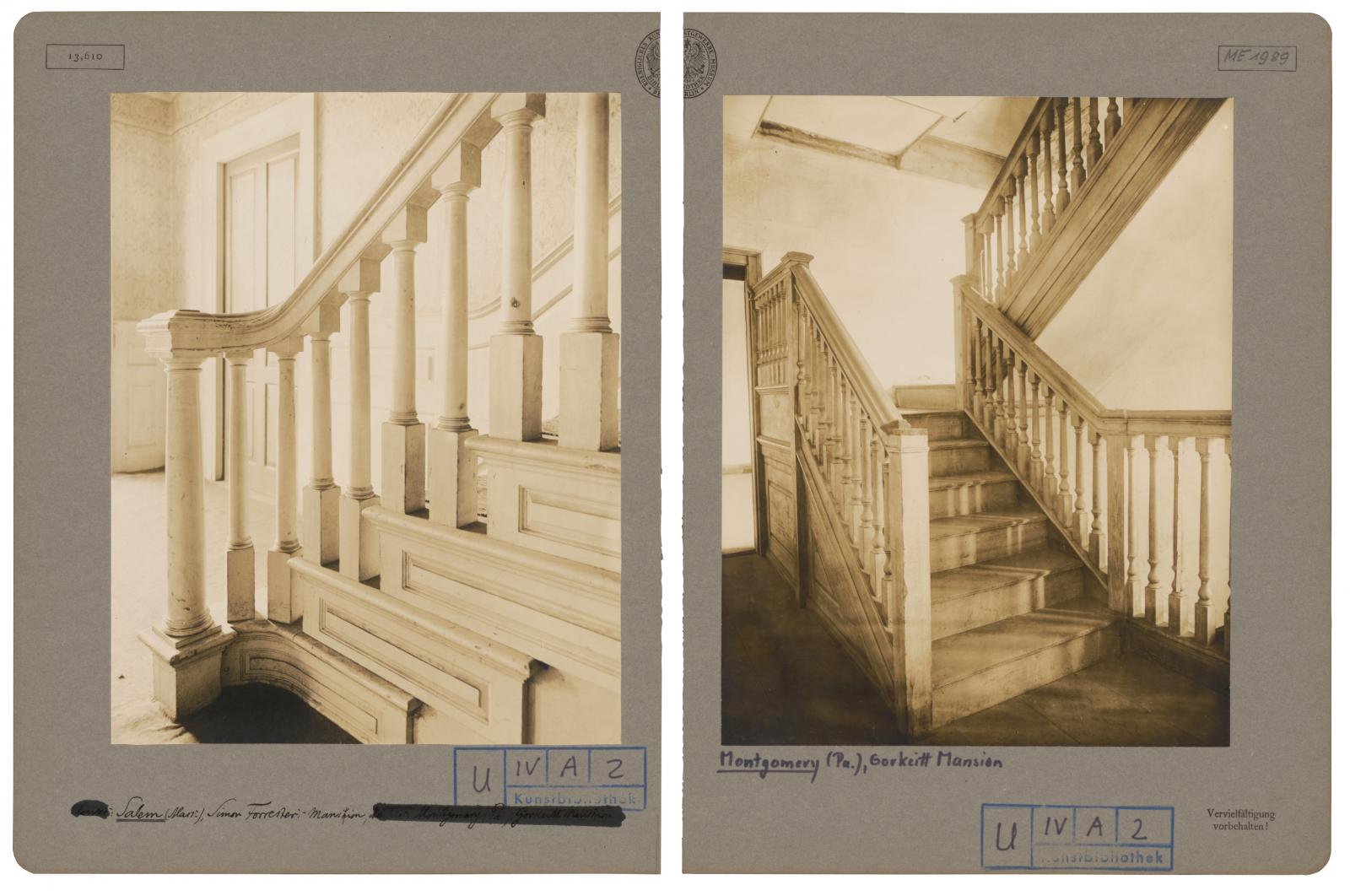
2 | Frank Cousins, “Salem (Mass.), Simon Forrester Mansion; Montgomery (Pa.), Gorkeitt Mansion”, about 1900, gelatin silver print on card mount, 24.1 x 18.9 cm (photo on the left), 23.9 x 18.8 cm (photo on the right), inv. no. 1913,610. Digital photograph by Dietmar Katz (Staatliche Museen zu Berlin, Kunstbibliothek), 2017.
The Hahne-Niehoff-Archiv at the Institut für Europäische Ethnologie of the Humboldt-Universität zu Berlin is a photo collection documenting Middle-German rural customs, established between the 1920s and 1944 with the programmatic aim to demonstrate the continuity of the German ‘Volk’. After 1945 the collection went to East Berlin and was incorporated into the Akademie der Wissenschaften of the DDR. It contained photographic films and materials, but also roughly 11,000 record sheets with photographs and data from ethnographic surveys. The record sheets were cut and reused: hundreds of pictures were cut out, pasted on file cards and became part of a file on rural customs that was continued with photographs taken in surveys conducted by the DDR academy. Many other record sheets were just cut into strips and repurposed as separators in folders. These practices show, among others, the endurance of ethnology methods between the Weimar Republic, Nazi Germany and the DDR. Finally, these photo-objects were shown [Fig. 2] in the 2018 Berlin exhibition Unboxing Photographs. Working in the Photo Archive [2], where they could take on a further function as exhibition items, serving the curators’ programmatic aims. The two case studies stress the idea that photographic documents are not just collected and preserved in archives; rather, they are produced by the technologies of the archive as well as by the work of archivists, scholars and curators as “historically-situated” actors (Schwartz 1995, 62).
Actually, the cut is omnipresent in the everyday life of a photo archive, and not only in special phases of its history. Consider the Photothek of the Kunsthistorisches Institut in Florenz, Max Planck Institute (hereinafter KHI), as one of the ecosystems in which photographic materiality manifests itself. I, too, operate in this ecosystem as a “historically-situated” actor, as I have been the head of the Photothek since 2006. The KHI was founded in 1897 on the initiative of scholars from the German-speaking area and included a collection of photographs from the very beginning. It was intended to serve as a base station for art-historical research focused on Italy. For over 120 years the Photothek has been collecting photographic reproductions of works of Italian art and architecture (Dercks 2013, 2014), selecting, cataloguing, arranging, and making them available to scholars – also through cutting. Scissors or rather paper cutters come to the stage very early when photographs are processed to enter the Photothek’s holdings. The white borders have to be trimmed before the photographic print, according to its size, can be pasted onto one of the card mount formats used in the Photothek: standard (c. 24 x 34 cm), large (c. 31 x 37 cm), extra-large (c. 55 x 75.5 cm), each corresponding to the size of a box or folder.
The production of the card mounts is a fundamental step in the entire archiving process. It includes cutting the cardboard itself to the appropriate size, cutting and pasting the photograph, adding stamps and inscriptions with the inventory number, the shelf mark according to the classification system, the description of the item as well as any additional information that may come to light in the ‘biography’ of a photo-object, such as a new attribution of the item represented or a digital reproduction number.
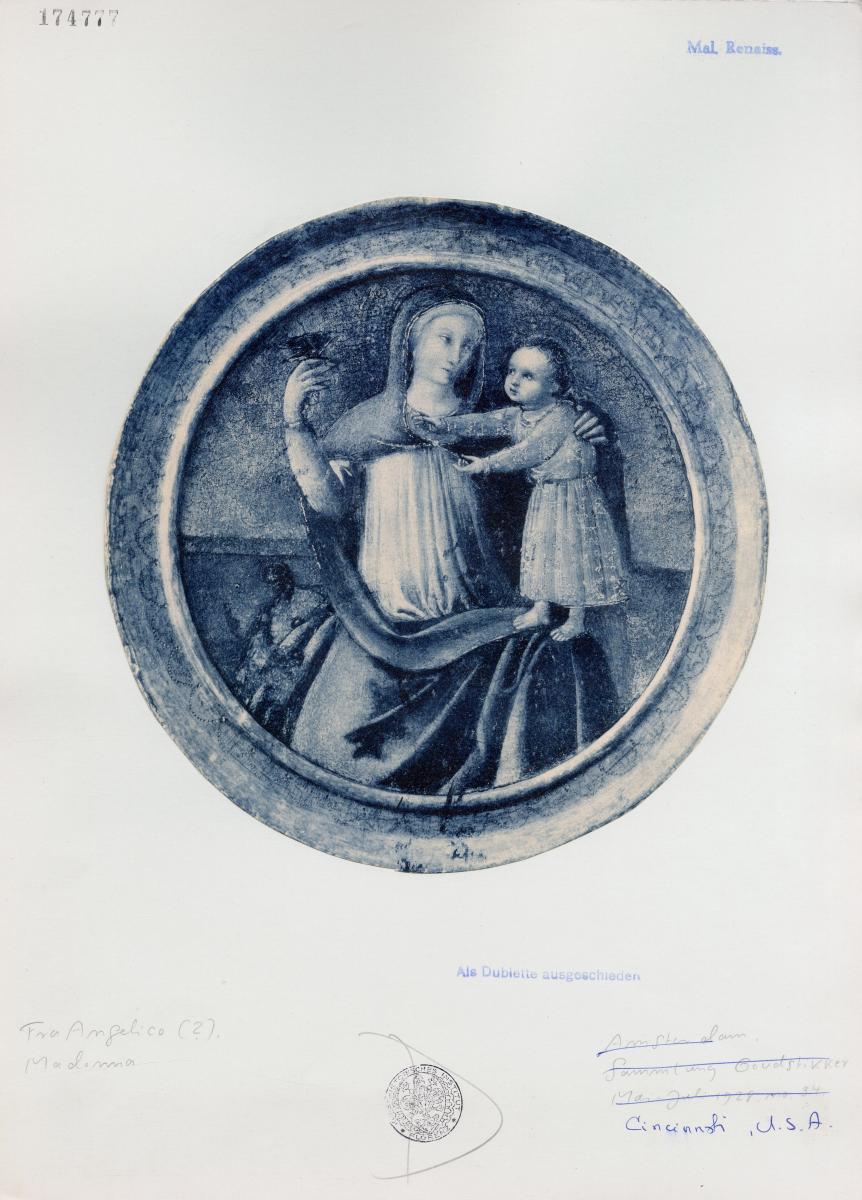
3 | Circle of Fra Angelico, Madonna and Child, collotype, 1928, 18.6 cm (diameter, print), 34 x 24.5 cm (mount), KHI inv. no. 174777, inventoried in 1966, discarded as doublet at an unknown time. Scan by Digitallabor KHI, 2020.
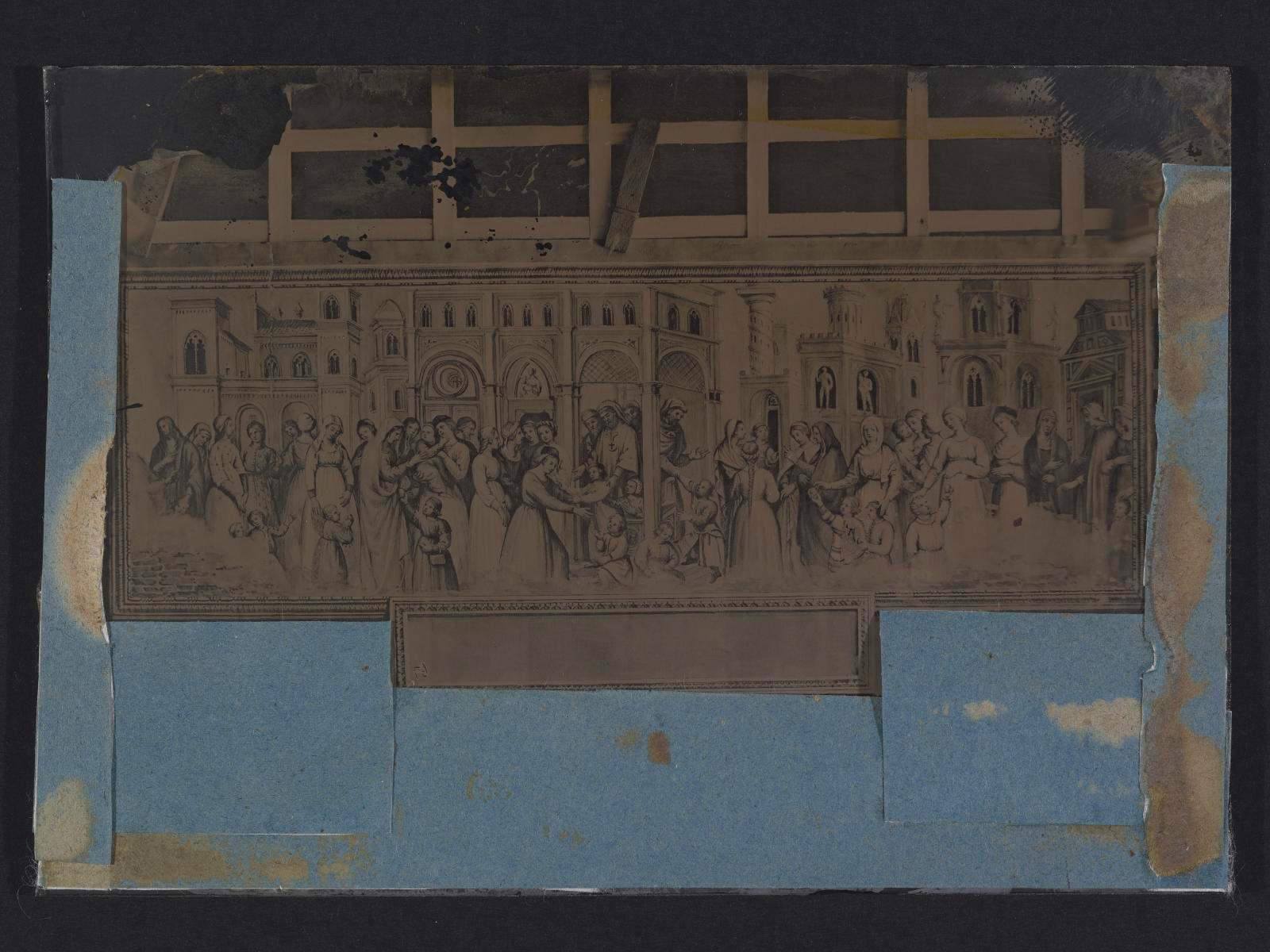
4 | Anton Hautmann, photographic reproduction of a drawing after the fresco The Captains of the Misericordia Deliver Children to their New Mothers by Niccolò Gerini and Ambrogio di Baldese, collodion wet plate, retouched with paper and color, before 1862, 13 x 18 cm (glass plate), KHI neg. no. 0350. Digital photograph by Digitallabor KHI, 2019.
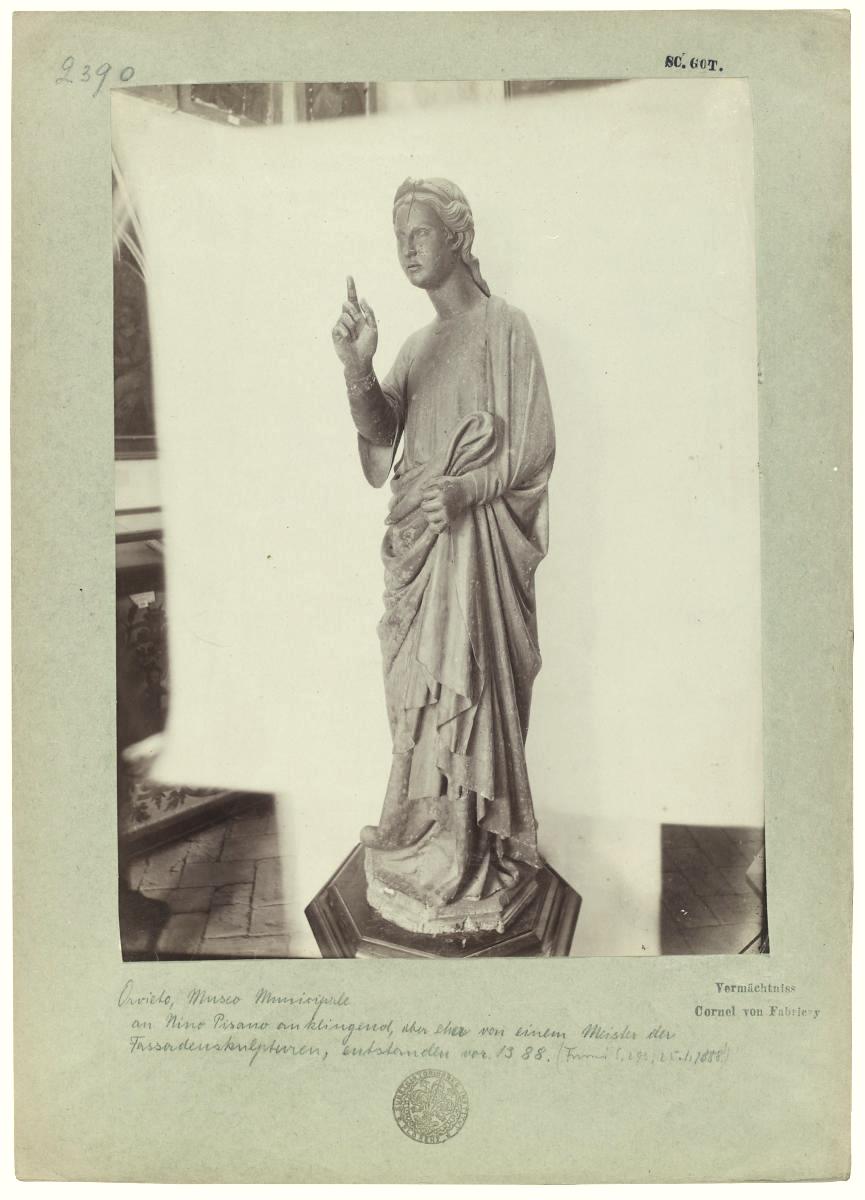
5 | Premiata Fotografia Luigi Raffaelli-Armoni, Angel of the Annunciation from the Museo dell’Opera del Duomo in Orvieto, albumen print, before 1898, 25.3 x 18.6 cm (photo), KHI inv. no. 2390. Digital photograph by Digitallabor KHI, 2009.
Cardboards are essential to documentary photographs because they allow them to perform their function as evidence: they are stiffer than photographic prints and can be held and handled without touching the delicate surface of the pictures. They also offer the necessary space for stamps and inscriptions that can be read simultaneously while examining the picture, transforming the photograph both into an institutional and a scientific photo-object (Edwards 2014). Moreover, they work as evidence of the archival history of the photo-objects themselves.
The Photothek’s cardboards were not cut in-house but rather purchased already cut to the right size. When a donation or bequest entered the holdings, sometimes the cardboards had to be cut to adapt them to the Photothek’s archive boxes. This was done without any concern for the material traces they presented, leading, in some cases, to the loss of important information (an example in Caraffa 2015, 35, fig. 4). In some other cases, it was the cardboard that was cut, producing four diagonal slits in which to insert the four corners of the print – a technique that is known to everyone from old family albums.
Sometimes, either in the Photothek or by the former collector, the photographs were trimmed [Fig. 3] to the shape of the work of art represented in them (a tondo, a gothic altar panel in a gabled frame) before pasting them on the card mounts. This is the most radical form of the decontextualization of the work of art that is a common feature of photographic documentation in art history. Cutting out the environment – be it a church, a museum interior, a dealer’s showroom – was recommended to enhance the aesthetic qualities of the represented object (Johnson 2013).
This decontextualization was often accomplished through retouching techniques. Retouching mainly took place on the glass plate negatives, scraping with knives, drawing or painting on the emulsion surface. Most frequently, photographic documentation of works of art shows the retouching of the background, that was completely painted over or covered with a paper template, cut in the appropriate shape [Fig. 4].
In other cases, to the same end a piece of white cloth [Fig. 5] was hung behind the object while taking the photograph, often combining this with retouching. Retouching could occur also on the positive, often with the aim of highlighting the objects and preparing the image to serve as an illustration in a book or catalogue. Retouching is a means for eliminating unwanted details that are recorded by the act of photographing but are considered disturbing by those using the picture. This practice leads back to the lively mid-19th-century debate that accompanied the adoption of photography as a tool and medium of art history.
While some art historians and connoisseurs deplored the fact that photography would cut out the colors and the materiality of the art objects, others criticized photography for not cutting out enough: it does not filter out intrusive elements such as, again, the environment, but also, for instance, stains and tears on a sheet of paper in the case of old master drawings. Early critics praised old reproduction techniques such as etching and lithography exactly because they were able to render a cleaned image of the work of art, eliminating the rest (Caraffa 2009, 13-14, 17).
Scissors are at work in many other daily tasks of a photographic archive (or in a photographer’s studio), for instance archiving film negatives. Cutting a negative strip into portions or single frames to put them into appropriate sleeves is often a necessary conservation measure, on the other hand the cut rescinds the temporal sequence of the frames. The use of passepartouts is another conservation and presentation form that, with the aim of protecting the fragile photographic print, tends to cut out the photographic image from its context. Passepartouts are used mainly for the proper and safe handling of fine art photographs, similarly to old master drawings. However, sometimes they are unavoidable in an archive of documentary photography, for instance when photographs are loaned to exhibitions. To which extent the viewer’s gaze is directed and formed by the framing provided by the passepartout was shown by an installation in the exhibition Unboxing Photographs, which played with the reversal of the passepartout principle: in a vitrine, a piece of ivory-white cardboard was cut in the shape and size of a photograph and laid on it to cover only the image. The effect was emphasis on the remaining part of the photo-object with the card mount and its stamps and inscriptions that are normally hidden by a traditional passepartout. This is again a hint to the processes of framing, re-framing and de-framing that are implicit in photographic as well as in archival practices.
A cut in a photo archive can also be intended as removal: when photo-objects are discarded, they are cut out from the ‘official’ holdings, even if they are not physically eliminated. I continue to use the practices of the Florentine Photothek as an example, with the necessary disclaimer that not every archive functions the same way – and yet, diving into the everyday life of a specific photo archive is helpful in order to understand the general mechanisms.
Cutting as discarding occurs for instance with the so-called duplicates: when a ‘new’ photograph documenting a certain art object entered the Photothek, the corresponding ‘old’ picture was often removed and put in the boxes of the Dubletten or Duplicates [3]. Over time, some duplicates were given to other institutions as exchange materials and were hence irrevocably cut off. Many boxes of duplicates are still kept in the Photothek and, for the past ten years, have been a quarry of interesting findings: from our current scholarly and archival point of view, a blurred albumen print scattered with scribbles and stamps might be much more remarkable (that means valuable) than the neat silver gelatin print of the same subject that replaced it a century ago. This example shows very clearly the (changing) systems of value that govern the life of a photo archive. For a photograph moving from one box to another very often means a downgrade, for instance if it moves to the Duplicates, that is to the metaphorical and physical margins of the archive. However, it can also mean an upgrade, as is the case if the photograph moves from the Duplicates directly to our special collections called Cimelia Photographica.
Yet, this type of move is not intended as a process of musealization. A well-known phenomenon, related to the fine art photography market, is the ‘discovery’ of photographic storage materials that were ‘anonymous’ up to then, with the subsequent canonization of personalities as artists (think of Vivian Maier) or of individual photographs as works of art. This process of apparent appreciation cuts the photographs from their original context to put them into a (often private) museum collection. At the Photothek there is awareness that moving some photo-objects to the Cimelia Photographica should not mean that they are cut from the archive as a whole. Rather, they keep being active within the ecosystem (Caraffa 2017, 134-137). It is not a question of claiming their artistic value, but rather of drawing attention to their genuine “archival value” (Vestberg 2008). Cutting out has always to do with value, or actually with changing values over time. A mindfulness of the systems of values that archivists apply while doing their job is necessary to avoid unwanted side-effects.
What is described here with the Duplicates can be likened to the very process of selection of new accessions that is implicit in each archive. Through its acquisition policy, a photographic archive such as the Florentine Photothek contributes to the formation and transformation of the art historical canon. Archival selection sanctions the canon through the inclusion of certain photographs (and of the works of art represented in them), but also through the excision of other photographs and objects. Here again, cutting produces value.
The cross-section of archival procedures presented in this paper and conducted following the heuristic category of the cut reconnects with one of the main notions of current archival theory and practice: appraisal. Appraisal theory focuses on the archivists’ active role and responsibility in taking decisions about what records should or should not be kept in accordance with societal values (Cook 2011). Appraisal is a political act precisely because it states not only what is included, but also what is excluded (cut out) from the archive, that means marginalized, ignored, potentially destroyed. The selection that takes place in this phase contributes to the establishment of the canon of art history (or of any other academic discipline) in two ways. Firstly, it makes some photographs and the represented works of art available and accessible to scholars; and secondly the selection is validated by the authority of that specific archive and institution (Wilder 2011). There is a certain similarity too with the (pre-archival) selection proposed by photographers’ sale catalogues: these were the main tools that documentary photographic collections used in making their systematic acquisitions and also a kind of first-level inventory of artistic heritage, driven not least by commercial concerns (Cavanna, Mambelli 2019). Artworks and monuments that for a variety of reasons are not accessible to photographers risk being cut out from the canon. One of these reasons can also be the cut of financial support to a given research project which, in the end, has to be accomplished without the help of a new photographic campaign. In general, any funding cut produces very material results in a photo archive, which can react for instance by cutting the number of new acquisitions or substituting expensive photographic acquisitions with cost-free clippings from print proofs.
The figure of cut in photo archives helps us to highlight forms of exclusion, for instance in cataloguing as well as in digitization campaigns. Which information is, or is not, given on the card of a card catalogue, or on the mount of a photograph, or in the corresponding dataset in a database? Which parts of the holdings are, or are not digitized according not least to the available funding? Any decision in this sense also corresponds to a cut of knowledge that is not transmitted to the users and that shapes the affordance of the photo-objects and of the archive in its entirety. Lastly, traditional practices in photo archives tend to cut out people, mainly archivists, who for generations have been shaping the photographic documents and the archival structures, as if their anonymity reinforces the neutrality of the archive as an institution.
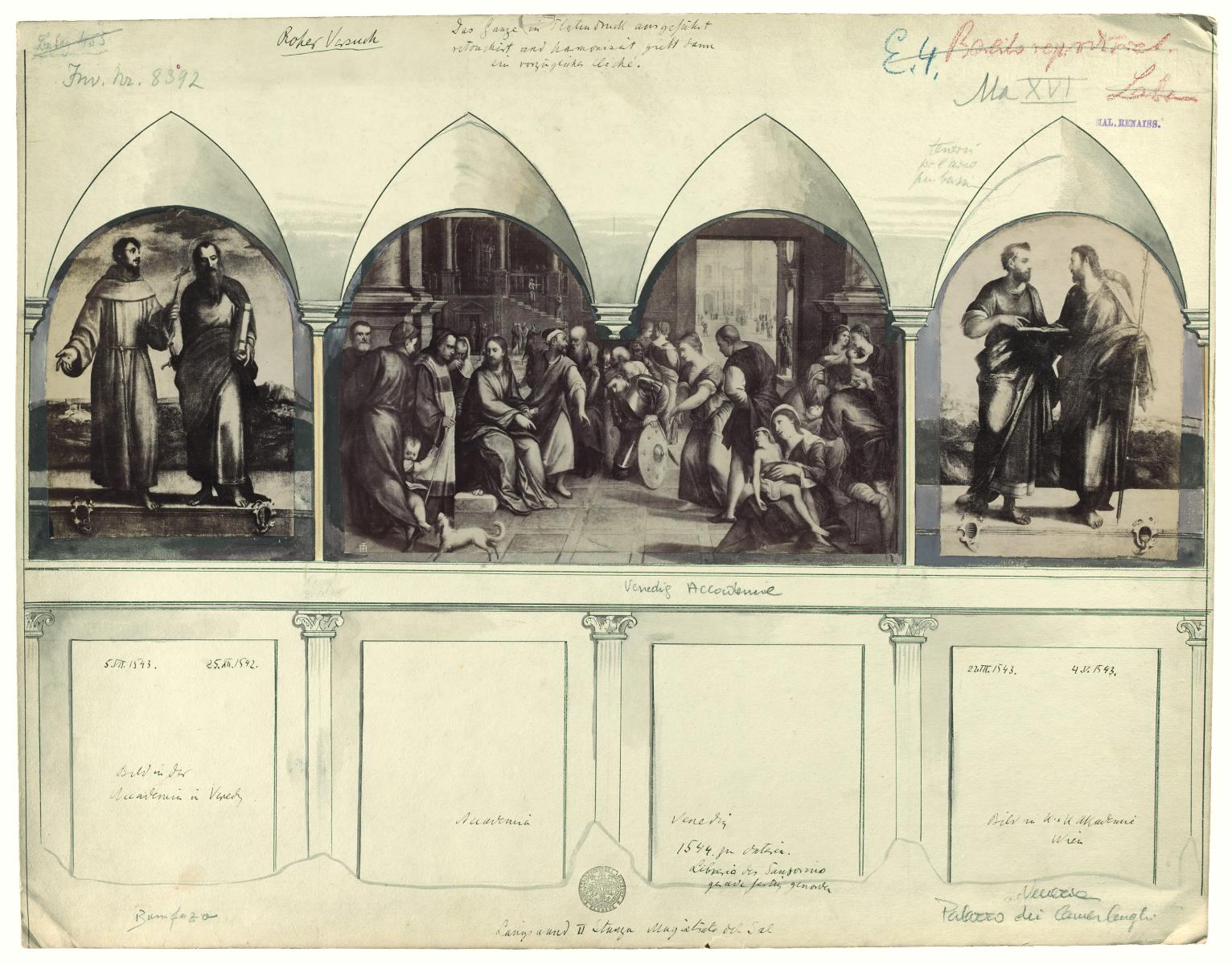
6 | Gustav Ludwig’s reconstruction of the mural decoration in the second room of the Magistrato del Sale, Palazzo dei Camerlenghi in Venice, wash drawing and albumen prints with Ludwig’s handwritten annotations, before 1901, 41.7 x 53.5 cm (mount), KHI inv. no. 8392. Digital photograph by Digitallabor KHI, 2011.
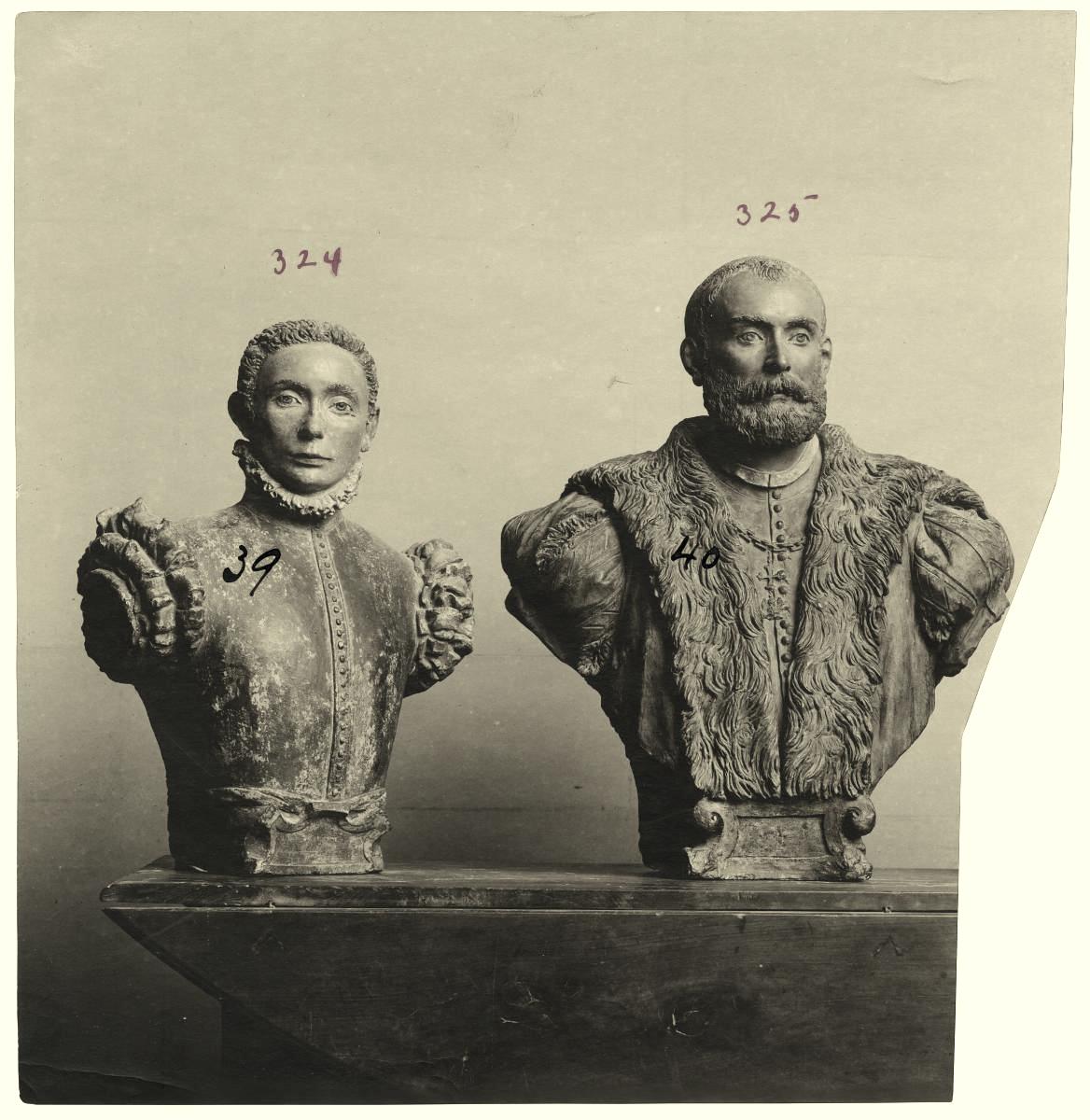
7 | Unknown photographer, bust of a man and a woman, probably from the legacy of Elia Volpi, gelatin silver print, before 1918, 18 x 15.5-17.5 cm, KHI inv. no. 607441. Scan by Digitallabor KHI, 2013.
The Photothek of the Kunsthistorisches Institut in Florenz is not only made by cutting, it is in itself an archive of cutting practices in art history. The photographs as objects bear the traces not only of their archival, but also of their pre-archival itineraries. Thus, many photographs in the Photothek’s holdings come from donations and bequests of scholars and permit a glimpse into their intellectual and also material laboratory.
A good example is the bequest of Gustav Ludwig (1854-1905), who contributed to the foundation of the Kunsthistorische Institut in 1897. When his bequest came to the Insitut in 1906, it was cut, that is to say dismembered: the books went to the Institute’s Library, the written documents and annotations went to the Archive, and the photographs went to the Photothek. This collection of approximately 2,500 pictures, mainly on Renaissance art in Venice, was inventoried in 1908 and dismembered again: the single photo-objects were separated according to the classification system that is based on the represented object. At the time, some of the photo-objects from the Ludwig legacy appeared problematic or not clear enough from the point of view of documentation, so they were put aside and inventoried only later, around 1930 or even in 2009.
While processing these plates around 1900, Ludwig was faced with the task of putting together visual information (the photographs of scattered works of art), archival data from his extensive studies in Venetian archives, as well as the pure reconstruction of the spatial context, which was assigned to a draftsman (Caraffa 2011b, 25-43; Caraffa Goldhahn 2013; Caraffa 2019). Ludwig’s collages [Fig. 6] or assemblages are based literally on cut and paste combined with drawings, painted areas and written annotations, from the dates of the archive documents to instructions to the publishing house. These plates are true palimpsests with multiple – also temporal – layers, that extend to the traces left on them by the archive such as inventory numbers and captions.
In the art market too, different forms of cut and paste were applied to make photographs into business instruments. Lynn Catterson (2020) has recently reconstructed such practices within the establishment of Stefano Bardini, one of the leading art dealers active in Florence in the last decades of the 19th and the beginning of the 20th century. Bardini’s photographs were used among others for the preparation of displays and auctions, some of them are preserved in the Photothek [Fig. 7].
In the previous pages, cut has proven itself as a very useful metaphor and heuristic category for exploring the epistemological potential of (art-historical) photo archives; the material approach has been helpful in highlighting the mechanisms of knowledge production. Reconstructing some of the practices that shape and shaped photographic objects and documents over time proves beneficial to highlight the role of the Photothek – and of photo archives in general – as laboratories of academic disciplines. Moreover, armed with metaphorical scissors I have tried to deconstruct some of the assumptions that still accompany a very widespread view of archives, photography, and sciences, especially concerning their presumed objectivity and neutrality. This is explicitly intended as a contribution to the international, cross-disciplinary debate on the role and function of photographs and photographic archives in scholarship as well as in post-digital societies. At the same time, it provides food for thought for a re-definition of our own role as archivists and scholars and curators.
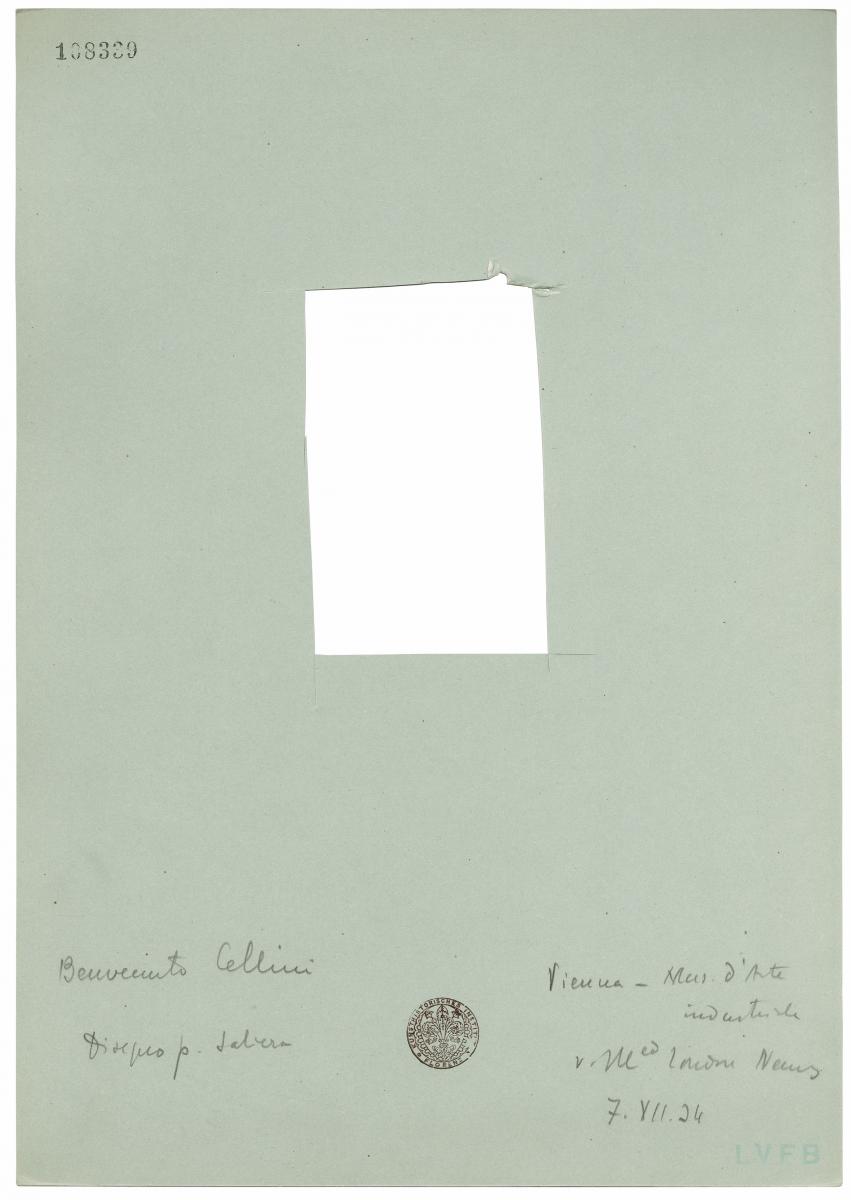
8 | Card mount with information about the missing picture: “Benvenuto Cellini / Disegno p. Saliera / Vienna - Mus. D’Arte / industriale / v. Illed London News / 7. VII. 24 / LVFB [Luigi Vittorio Fossati Bellani]”, 34 x 24 cm (cardboard), acquisition date: 26 February 1936, KHI inv. no. 108339. Scan by Digitallabor KHI, 2020.
In this spirit, we could also use the ‘cut and paste’ metaphor to characterize the Photothek's collaboration with the artist Armin Linke, who has included photographic objects ‘extracted’ from the Photothek in some of his latest exhibitions (Linke 2020) [4].
In conclusion, I would like to return to the subject of the margins of the archive, which I have touched on a few times. The cut, as Linda Bertelli and Maria Luisa Catoni suggest in their introduction to this issue of Engramma, always has to do with the borders produced by more or less metaphorical scissors. Along these edges, together with the Duplicates and other boxes of photographs removed from the center of the Photothek for various reasons, there is a box labeled “Fehlende Fotos”, missing photographs. Saying that missing photographs can be collected in a box may seem strange at first glance. The box in question contains the card mounts of the missing photographs, that is, photographs that have been stolen over time. Generally, they were torn from the cardboard; in one case the photograph was literally cut away leaving a rectangular hole in the mount [Fig. 8]. The cardboards in the “Fehlende Fotos” box always provide detailed information about the stolen photograph. All the inscriptions and stamps are clearly visible on the mount so we can read all about the work represented in the photograph, the inventory number that can allow us to go back to the date of the inventory, sometimes there is the photographer’s name or even the provenance of the photograph. Often the date when the archivists detected the theft is written on a post-it. What we can no longer – or ever again – see is the photograph itself, either as an object or its visual content. In Barthes’s terms, the cardboard with its cut can be interpreted as a reference or index to the fact that the photo-object “has been there” [5]. Cutting in this case means loss, literally a hole that can never be filled. But, we can look through this hole to discover new photographic itineraries in the archive.
Notes
[1] I elaborate on the archival implications of the photographic cut in a slightly longer version of this paper that will be published in Sue Breakell and Wendy Russell (eds), The Materiality of Archives: Creative Practice in Context, London: Routledge, forthcoming 2021. I would like to express my gratitude to all the colleagues of the Photothek who helped me to identify relevant materials in our holdings, especially Dagmar Keultjes. Helga Auer provided invaluable assistance in the editing of bibliographic references and images. Special thanks to Tiziana Serena for our enlightening conversations.
[2] Unboxing Photographs: Working in the Photo Archive, Kunstbibliothek, Staatliche Museen zu Berlin, 16 February 2018 to 27 May 2018, curatorial concept by Julia Bärnighausen, Costanza Caraffa, Stefanie Klamm, Franka Schneider, and Petra Wodtke (https://www.smb.museum/en/exhibitions/detail/unboxing photographs/) [accessed 31 Aug 2020].
[3] However, this only happened with pictures representing the art object from the very same point of view. In other words, the decision to deaccess a duplicate was taken not in consideration of its visual content, which is identical or almost identical to that of the new acquisition, but rather on the basis of its materiality (blurred, faint, damaged, scribbled and similar).
[4] On other artistic projects curated by the Photothek, see Belmonte et al. 2018; Guidi 2018.
[5] In his seminal work Camera Lucida, Roland Barthes described the indexical nature of photography: each photograph confronts us simultaneously with the absence of the person or object represented and the certainty that it "has been there" (Barthes [1980] 1981, 115) in front of the camera at the moment of the shutter click.
Bibliography
- Bärnighausen, Caraffa et. al. 2019
J. Bärnighausen, C. Caraffa, S. Klamm, F. Schneider, P. Wodtke (eds.), Photo-Objects. On the Materiality of Photographs and Photo Archives in the Humanities and Sciences, Berlin 2019 [online], accessed 17 August 2020]. - Barthes [1980] 1981
R. Barthes, Camera Lucida: Reflections on Photography [La chambre claire. Note sur la photographie, Paris 1980], translation by R. Howard, New York 1981. - Belmonte, Di Cecco et. al. 2018
C. Belmonte, A. Di Cecco, E. Scirocco, G. Wolf, Photography and Catastrophe. Antonio Di Cecco in dialogue with the collections of the Photo Library, 2018 [online exhibition], accessed 18 August 2020. - Caraffa 2009
C. Caraffa (hrsg. v.), Fotografie als Instrument und Medium der Kunstgeschichte, Berlin 2009. - Caraffa 2011a
C. Caraffa (ed.), Photo Archives and the Photographic Memory of Art History, Berlin, Munich 2011. - Caraffa 2011b
C. Caraffa, From “Photo Libraries” to “Photo Archives”: On the epistemological potential of art-historical photo collections, in Id. (ed.), Photo Archives and the Photographic Memory of Art History, Berlin, Munich 2011, 11-44. - Caraffa 2015
C. Caraffa, Archival Isles, Presences of Disappearance: The Croquison Donation in the Photothek of the Kunsthistorisches Institut in Florenz, “PhotoResearcher” 23 (2015), 28-39. - Caraffa 2017
C. Caraffa, Manzoni in the Photothek: Photographic Archives as Ecosystem, in Buddeus, H., Mašterová, K., Lahoda, V. (eds.), Instant Presence: Representing Art in Photography: In Honor of Josef Sudek (1896-1976), Prague 2017, 121-136. - Caraffa 2019
C. Caraffa, The photo archive as laboratory: Art history, photography, and materiality, “Art Libraries Journal” 44/1 (2019), 37-46, Accessed 27 August 2020. - Caraffa 2020
C. Caraffa, Photographic Itineraries in Time and Space: Photographs as Material Objects, in G. Pasternak (ed.), Handbook of Photography Studies, London, New York, Oxford, New Delhi, Sydney 2020, 79-86, accessed 27 August 2020. - Caraffa, Goldhahn 2013
C. Caraffa, A. Goldhahn, Fotografien als Forschungsobjekte – Der Nachlass Gustav Ludwigs in der Photothek des Kunsthistorischen Instituts in Florenz, in I. Ziehe, U. Hägele, Fotografie und Film im Archiv: Sammeln, Bewahren, Erforschen, Münster, New York, Munich, Berlin 2013, 73-84. - Catterson 2020
L. Catterson, From Visual Inventory to Trophy Clippings: Bardini & Co. and the Use of Photographs in the Late Nineteenth-Century Art Market, in C. Caraffa, J. Bärnighausen (eds.), Mitteilungen des Kunsthistorischen Instituts in Florenz: Photography and the Art Market around 1900, 62/1 (2020), 69-92. - Cavanna, Mambelli 2019
P. Cavanna, F. Mambelli (a cura di), Un patrimonio da ordinare: i cataloghi a stampa dei fotografi, Bologna 2019. - Cook 2011
T. G. Cook, “We Are What We Keep; We Keep What We Are”: Archival Appraisal Past, Present and Future, “Journal of the Society of Archivists” 32/2 (2011), 173-189. - Dercks 2013
U. Dercks, Ulrich Middeldorf prior to emigration: The Photothek of the Kunsthistorisches Institut in Florenz (1928-1935), “Art Libraries Journal” 38/4 (2013), 29-36, accessed 27 August 2020. - Dercks 2014
U. Dercks, “And because the use of the photographic device is impossible without a proper card catalog … ”: The Typological-Stylistic Arrangement and the Subject Cross-Reference Index of the KHI's Photothek (1897-1930s), “Visual Resources”, 30/3 (2014), 181-200, accessed 27 August 2020. - Dubois 1983
Dubois, L’acte photographique et autres essais, Paris, Brussels 1983. - Edwards 1992
E. Edwards (ed.), Anthropology and Photography 1860-1920, New Haven 1992. - Edwards 2001
E. Edwards, Raw Histories: Photographs, Anthropology and Museums, Oxford, New York 2001. - Edwards 2014
E. Edwards, Photographs, Mounts and the Tactile Archive, “19: Interdisciplinary Studies in the Long Nineteenth Century” 0/19 2014 [online], accessed 17 August 2020. - Edwards 2019
E. Edwards, Thoughts on the “Non-Collections” of the Archival Ecosystem, in J. Bärnighausen, C. Caraffa, S. Klamm, F. Schneider, P. Wodtke (eds.), Photo-Objects. On the Materiality of Photographs and Photo Archives in the Humanities and Sciences, Berlin 2019, 67-82 [online], accessed 17 August 2020. - Edwards, Hart 2004
E. Edwards, J. Hart (eds.), Photographs Objects Histories: On the Materiality of Images, London, New York 2004, accessed 27 August 2020. - Galassi 1981
P. Galassi Before Photography: Painting and the Invention of Photography, New York 1981. - Geimer 2007
P. Geimer, Image as Trace: Speculations about an Undead Paradigm, “differences” 18/1 2007, 7-28. - Guidi 2018
G. Guidi, Guido Guidi: Appointment in Florence, C. Caraffa, T. Serena (eds.), Cologne 2018. - Johnson 2013
G. A. Johnson, “(Un)richtige Aufnahme”: Renaissance Sculpture and the Visual Historiography of Art History, “Art History” 36 (2013), 12-51, accessed 27 August 2020. - Klamm, Schneider 2020
S. Klamm, F. Schneider, Der große Schnitt, in J. Bärnighausen, C. Caraffa, S. Klamm, F. Schneider, P. Wodtke (hrsg. v.), Foto-Objekte: Forschen in archäologischen und kunsthistorischen Archiven, Bielefeld, Berlin 2020, 168-17 - Linke 2020
A. Linke, Armin Linke: Modalities of Photography. M. Balduzzi (ed.), Milan 2020. - Mitman, Wilder 2016
G. Mitman, K. Wilder (eds.), Documenting the World: Film, Photography, and the Scientific Record, Chicago, London 2016. - Pinney 1997
C. Pinney, Camera Indica: The Social Life of Indian Photographs, London 1997, accessed 27 August 2020. - Pinney 2003
C. Pinney, Introduction, in C. Pinney, N. Peterson (eds.), Photography’s Other Histories, Durham 2003, 1-14. - Rose 2000
G. Rose, Practising Photography: An Archive, a Study, Some Photographs, and a Researcher, “Journal of Historical Geography” 26/4 (2000), 555-571. - Schwartz 1995
J. M. Schwartz, “We make our tools and our tools make us”: Lessons from Photographs for the Practice, Politics and Poetics of Diplomatics, “Archivaria” 40 (1995), 40-74. - Schwartz 2000
J. M. Schwartz, "Records of Simple Truth and Precision”: Photography, Archives, and the Illusion of Control, “Archivaria” 50 (2000), 1-40. - Schwartz 2011
J. M. Schwartz, The Archival Garden: Photographic Plantings, Interpretive Choices, and Alternative Narratives, in T. Cook (ed.), Controlling the Past: Documenting Society and Institutions: Essays in Honor of Helen Willa Samuels, Chicago 2011, 69-110. - Szarkowski 1966
J. Szarkowski, The photographer’s eye, New York 1966. - Vestberg 2008
N. L. Vestberg, Archival Value: On photography, materiality and indexicality, “photographies” 1/1 (2008), 49-65, accessed 27 August 2020. - Wilder 2011
K. Wilder, Locating the Photographic Archive of Science, in C. Caraffa (ed.), Photo Archives and the Photographic Memory of Art History, Berlin, Munich 2011, 369-378.
English abstract
The theme of the cut, of the portion of reality that the photographic technique cuts out and freezes outside the time-space continuum, is intrinsic to photography. It has been analyzed by important curators and critics such as John Szarkowski and Philippe Dubois, whose work is historically related to the construction of a theory of photography as art. This paper, focuses on another type of photographic production: photographs in archives, which were traditionally cut out from official narratives based on museum values. Using examples from the Photothek of the Kunsthistorisches Institut in Florenz, Max Planck Institute, this paper analyzes how cutting practices that shape photographic objects and documents over time. It shows that cutting practices in photo archives should not be considered a form of destruction, but rather a transformation of the photographic objects. Moreover, cut will prove itself as a very useful metaphor and heuristic category for exploring the epistemological potential and the value systems of (art-historical) photo archives.
keywords | photography; materiality; cut; archive; practices; photo-objects; value systems.
La Redazione di Engramma è grata ai colleghi – amici e studiosi – che, seguendo la procedura peer review a doppio cieco, hanno sottoposto a lettura, revisione e giudizio questo saggio.
(v. Albo dei referee di Engramma)
Per citare questo articolo/ To cite this article: Costanza Caraffa, The photographic cut and cutting practices in photographic archives, “La Rivista di Engramma” n. 179, febbraio 2021, pp. 65-83. | PDF dell’articolo
